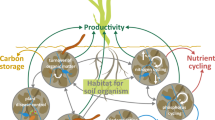Abstract
Inappropriate land use and soil mismanagement produced wide-scale soil and environmental degradation to the short-grass steppe ecosystem in the semiarid region of central east Kazakhstan. A limitation for determining the impacts of land use changes on soil organic carbon (SOC) is the dearth of information on SOC stocks under the predominant land uses in the region. Here we used the Environmental Policy Integrated Climate (EPIC) model to study long-term impacts of land use changes and soil management on SOC to a depth of 50 cm during 1955–2030, in degraded agricultural lands of central east Kazakhstan. Simulated land uses were: native rangeland vegetation, wheat (Triticum aestivum L.), wheatgrass (Agropyron cristatum L.), and abandoned croplands. The EPIC model was initialized with soil properties obtained from a soil map of the study area. Data on crop management, fertilizer application and tillage practices were gathered from local expert knowledge. Simulations were performed for each polygon on a land use classification map, resulting in 4661 simulations. Our results showed that simulated SOC explained 50% of the variation in measured SOC. Of the 1.38 million hectares in the study area, 78% were under native vegetation, 3% cultivated to wheat, 8% on wheatgrass, and 11% were abandoned croplands in 2005. If land use remained constant, total stock of SOC would decrease at an annual rate of 723 kg C ha−1. However, if best management practices are implemented, resulting in reallocation of land use according to the land capability with abandoned croplands being converted to reduced-tillage wheat or wheatgrass, total stock of SOC would increase to an equivalent of 4700 kg C ha−1 yr−1. Combining land use classification and soil maps with EPIC, proved valid for studying impacts of land use changes and management practices on SOC; an important aspect of this approach is the ability to scale up site-specific SOC to the region. With the available data, EPIC produced relatively accurate results but more data on spatial and temporal variation in SOC are needed to improve model calibration and validation.
Similar content being viewed by others
References
Causarano H.J., Doraiswamy P.C., McCarty G.W., Hatfield J.L., Milak S., Stern A.J. (2008) EPIC modeling of soil organic carbon sequestration in croplands of Iowa, J. Environ. Qual. 37, 1345–1353.
Causarano H.J., Shaw J.N., Franzluebbers A.J., Reeves D.W., Raper R.L., Balkcom K.S., Norfleet M.L., Izaurralde R.C. (2007) Simulating field-scale soil organic carbon dynamics using EPIC, Soil Sci. Soc. Am. J. 71, 1174–1185.
Falloon P., Smith P. (2003) Accounting for changes in soil carbon under the Kyoto protocol: need for improved long-term data sets to reduce uncertainty in model projections, Soil Use Manage. 19, 265–269.
Gassman P.W., Williams J.R., Benson V.W., Izaurralde R.C., Hauck L.M., Jones C.A., Atwood J.D., Kiniry J.R., Flowers J.D. (2004) Historical development and applications of the EPIC and APEX models (ASAE Paper No.042097), ASAE, St. Joseph, MI.
Hargreaves G.H., Samani Z.A. (1985) Reference crop evapotranspiration from temperature, Appl. Eng. Agric. 1, 96–99.
Izaurralde R.C., Rosenberg N.J., Brown R.A., Thomson A.M. (2003) Integrated assessment of Hadley Center (HadCM2) climate-change impacts on agricultural productivity and irrigation water supply in the conterminous United States: Part II. Regional agricultural production in 2030 and 2095, Agric. For. Meteorol. 117, 97–122.
Izaurralde R.C., Williams J.R., McGill W.B., Rosenberg N.J., Jakas M.C.Q. (2006) Simulating soil C dynamics with EPIC: Model description and testing against long-term data, Ecol.Model. 192, 362–384.
Kaser M. (1997) The economics of Kazakhstan and Uzbekistan. London: The Royal Institute of International Affairs.
Kiniry J.R., Major D.J., Izaurralde R.C., Williams J.R., Gassman P.W., Morrison M., Bergentine R., Zentner R.P. (1995) EPIC model parameters for cereal, oilseed, and forage crops in the northern Great Plains region, Can. J. Plant Sci. 75, 679–688.
Lal R. (2004) Carbon sequestration in soils of central Asia, Land Degrad. Dev. 15, 563–572.
McCauley M. (1976) Khrushchev and the development of Soviet agriculture: The Virgin Land Programme, Holmes & Meier, New York, pp. 1953–1964.
Meng E., Longmire J., Moldashev A. (2000) Kazakhstan’s wheat system: priorities, constraints, and future prospects, Food Policy 25, 701–717.
Paustian K., Elliott E.T., Collins H.P., Cole C.V., Paul E.A. (1995) Use of a network of long-term experiments in North America for analysis of soil C dynamics and global change, Aust. J. Exp. Agric. 35, 929–939.
Priya S., Shibasaki R. (2001) National spatial crop yield simulation using GIS-based crop production model, Ecol. Model. 136, 113–129.
Rao M.N., Waits D.A., Neilsen M.L. (2000) A GIS-based modeling approach for implementation of sustainable farm management practices, Environ. Modell. Software 15, 745–753.
Smith P., Smith J.U., Powlson D.S., McGill W.B., Arah J.R.M., Chertov O.G. (1997) A comparison of the performance of nine soil organic matter models using datasets from seven long-term experiments, Geoderma 81, 153–225.
Tan G., Shibasaki R. (2003) Global estimation of crop productivity and the impacts of global warming by GIS and EPIC integration, Ecol. Model. 168, 357–370.
United States Geological Survey (2007) Seamless Data Distribution System [Online]. Available at http://seamless.usgs.gov (verified 23 July 2007).
Wang X., He X., Williams J.R., Izaurralde R.C., Atwood J.D. (2005) Sensitivity and uncertainty analyses of crop yields and SOC simulated with EPIC, Trans. ASAE 48, 1041–1054.
Williams J.R. (1990) The erosion-productivity impact calculator (EPIC) model: a case history, Philos. Trans. R. Soc. Lond. 329, 421–428.
Author information
Authors and Affiliations
Corresponding author
About this article
Cite this article
Causarano, H.J., Doraiswamy, P.C., Muratova, N. et al. Improved modeling of soil organic carbon in a semiarid region of Central East Kazakhstan using EPIC. Agronomy Sust. Developm. 31, 275–286 (2011). https://doi.org/10.1051/agro/2010028
Accepted:
Published:
Issue Date:
DOI: https://doi.org/10.1051/agro/2010028




